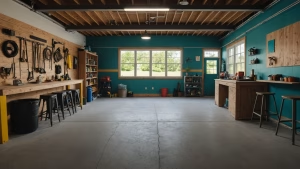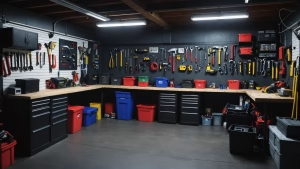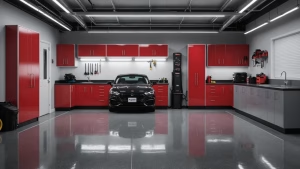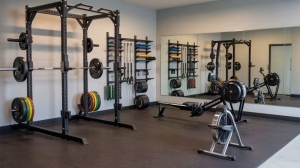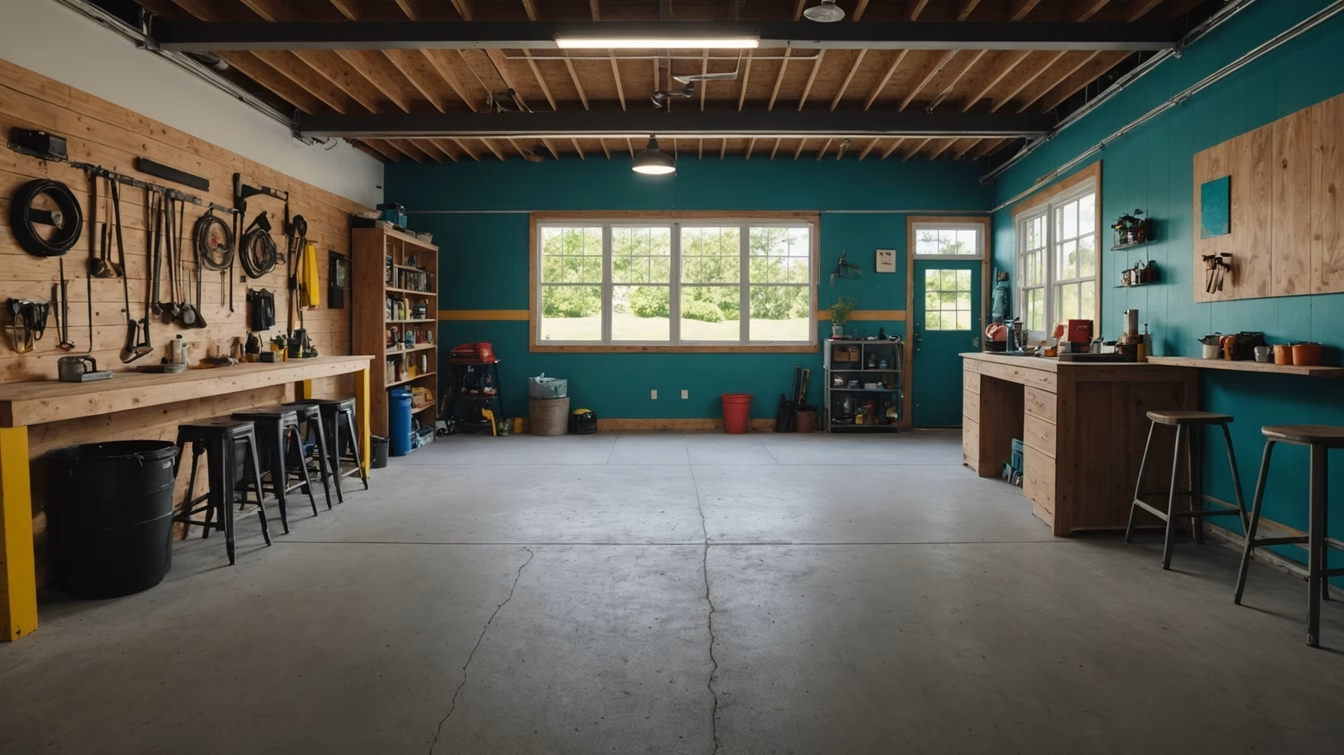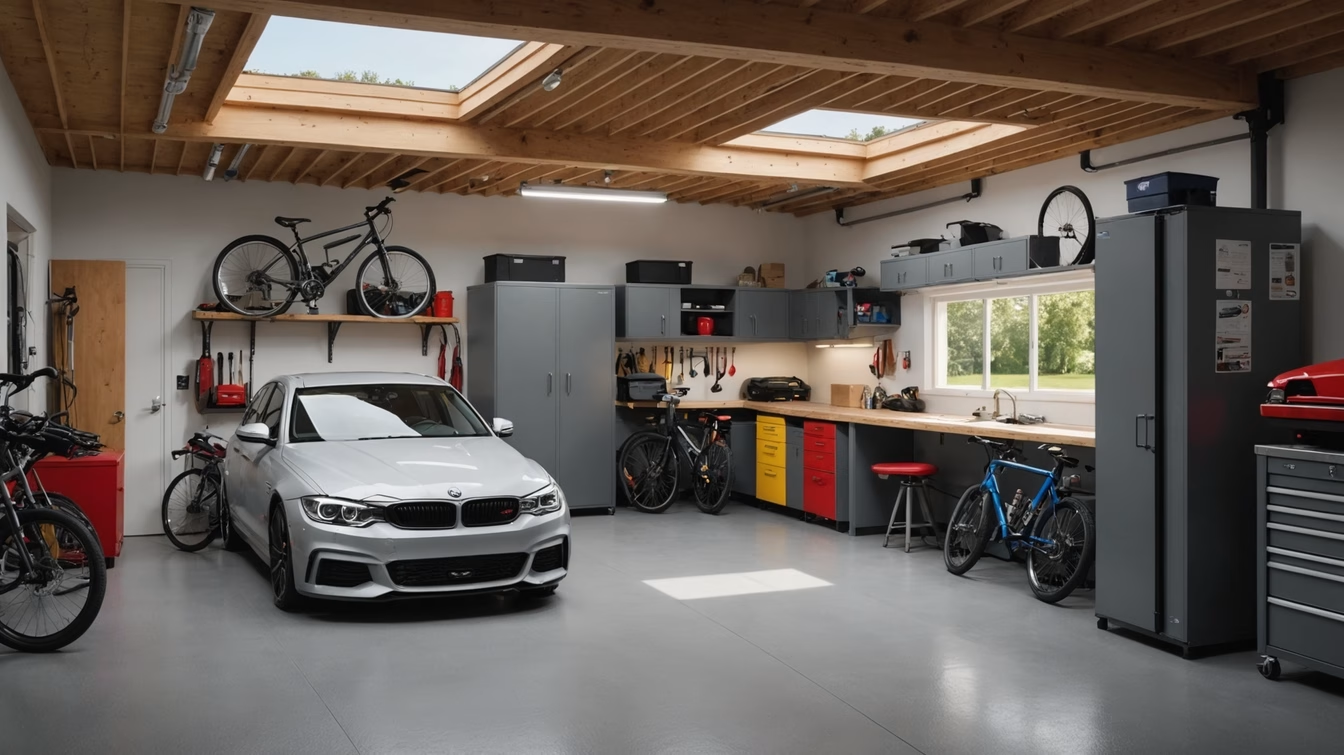Managing hot air in your garage is key to a comfortable and efficient workspace. Temperatures in garages often soar by 10-18°F (5-10°C) above outdoor levels. This is due to poor insulation and ventilation. Such conditions not only make your space uncomfortable but also increase energy costs.
This guide will delve into practical garage heating solutions and efficient strategies. We aim to help you cool down your garage. This will make it more enjoyable for your daily activities.
Understanding the Causes of Hot Air in Your Garage
Hot air buildup in your garage can be quite a nuisance. It’s vital to grasp the reasons behind this issue to find effective cooling solutions. Various factors contribute to this problem, including insulation and external influences.
Improper Insulation and Ventilation
Poor insulation and ventilation significantly impact garage temperatures. Insufficient insulation in walls, ceilings, and doors lets external heat in. Meanwhile, inadequate ventilation traps warm air inside. This combination leads to faster heating and longer retention of warmth. Effective heating solutions can help regulate temperatures year-round.
Garage Size and Design Impact
The size and design of your garage influence heat accumulation. Garages facing the sun, especially those with large windows, absorb sunlight, increasing internal temperatures. The layout also affects air circulation, making design optimization crucial. Experts recommend choosing materials and design elements to reduce heat buildup.
External Heat Sources
External heat sources are a major contributor to garage heat. Vehicles parked inside generate heat that lingers even after the engine is off. Nearby appliances or heat from walls can also worsen the situation. Identifying these sources is key to choosing the right cooling options for your garage.
Benefits of Reducing Hot Air in Your Garage
Reducing hot air in your garage offers numerous advantages. It can significantly enhance your daily activities and the longevity of your belongings. A cooler environment improves your experience and helps maintain your equipment. This reduction benefits various aspects.
Improved Comfort for Daily Use
A comfortable garage space makes hobbies, workouts, or vehicle maintenance more enjoyable. A cooler garage boosts productivity, allowing you to focus on your passions. Recognizing the benefits of a cooler garage leads to more frequent use and satisfaction.
Enhanced Equipment Longevity
Excessive heat can damage tools and equipment. A cooler garage preserves the integrity of these items, crucial for sensitive machinery. Efficient heating strategies extend equipment lifespan, reducing repair or replacement costs.
Increased Energy Efficiency
A cooler garage enhances energy efficiency in your home. It reduces the load on your HVAC system, lowering energy bills. This approach benefits both comfort and the environment, making it a sustainable choice.
Effective Ventilation Solutions for Garages
Creating a comfortable garage environment requires effective ventilation solutions. Managing hot air circulation is crucial for comfort and protecting stored items. Various methods can optimize airflow, ensuring your garage remains cool and functional.
Natural Ventilation Techniques
Natural ventilation is an energy-efficient approach to reduce heat. Opening doors and windows during cooler times allows for refreshing breezes. Vents strategically placed can create cross-ventilation, pushing hot air out and bringing cooler air in. This method is simple yet effective.
Mechanical Ventilation Options
Mechanical ventilation offers controlled air movement. Exhaust fans are key in actively removing hot air and introducing cooler air. These systems, installed on walls or ceilings, enhance airflow. They are vital in combating high temperatures during summer.
Whirlybird Roof Ventilators
Whirlybird roof ventilators use wind power to expel hot air. Strategically placed on the roof, they enable passive ventilation without electricity. The spinning action of whirlybirds efficiently draws hot air out, improving air exchange.
Insulation Strategies to Keep Your Garage Cool
Proper insulation is crucial for a cool garage environment. Using the right garage insulation materials can greatly reduce heat entry. This boosts your space’s efficiency. Focus on the best materials and techniques to keep your garage comfortable and functional.
Types of Insulation Materials
There are several insulation options for garages, each with its own advantages:
- Foam Boards: These rigid panels are highly effective at blocking heat and are easy to install on walls.
- Fiberglass Batts: A cost-effective choice, fiberglass batts are great for insulating walls.
- Spray Foam: This option offers superior coverage and air sealing, making it a top choice for garage heating.
Proper Installation Techniques
For effective garage insulation, pay close attention to installation details:
- Seal gaps around windows, doors, and electrical outlets to stop air leaks.
- Ensure complete coverage on walls, ceilings, and floors for better energy efficiency.
- Use vapor barriers when needed to manage moisture levels.
Insulating Garage Doors
Garage doors are a significant source of heat exchange. Insulating them improves comfort and supports cost-effective heating solutions:
Adding insulation kits for garage doors is a good idea. These kits include panels that fit perfectly, stopping heat loss. A tight fit keeps your garage cool in summer and lowers energy costs for heating and cooling.

Using Evaporative Coolers for Hot Air Relief
Evaporative coolers, also known as swamp coolers, are a great solution for hot garages. They work by cooling warm air through water-saturated pads before circulating it. This method is a refreshing alternative to traditional air conditioning systems.
How Evaporative Coolers Work
The operation of evaporative coolers is simple yet effective. Warm air meets moisture from the pads, cooling it down. This makes cooler air flow into the garage. They are especially beneficial in low-humidity areas, offering efficient cooling with low energy use.
Best Practices for Installation
Proper installation of evaporative coolers is key to their performance. Place them near fresh air sources for better airflow. If your garage is large or has obstacles, consider using multiple units. These strategies can improve your garage heating solutions.
Maintenance Tips for Longevity
Regular maintenance is crucial for the longevity of evaporative coolers. Clean the pads often to prevent clogs and ensure airflow. Also, check the water supply to keep it consistent. Proper maintenance will extend the life of your evaporative coolers, keeping your garage cool and comfortable.
Choosing the Right Fans for Air Circulation
Improving comfort and functionality in your garage starts with effective hot air circulation. The right fans can significantly impact temperature and airflow management. It’s crucial to understand the different fan types, their placement, and energy efficiency. This knowledge ensures a cost-effective and efficient solution for your garage’s air circulation needs.
Types of Fans for Garages
When choosing fans for your garage, consider these options:
- Oscillating Fans: Ideal for wide coverage, they move side to side for even air distribution.
- Pedometer Fans: Standing tall, they direct air at various angles, offering versatility.
- Box Fans: Compact and easy to move, they’re perfect for tight spaces and can be used for exhaust in windows.
Optimal Placement for Maximum Effect
For the best hot air circulation in your garage, placement is everything. Position fans near windows or doors to expel hot air and draw in cooler air. Here are some placement tips:
- Place a fan facing outwards in an open window to push hot air outside.
- Position a fan across from the entryway to create a cross-breeze.
- Utilize multiple fans for larger garages to maximize airflow.
Energy Efficiency of Fans
Fans can be an energy-efficient way to manage heat in your garage. Choose models that are energy-efficient to save on costs. Look for fans with low energy consumption ratings but strong airflow. This approach supports environmental sustainability and reduces electricity bills.
Creating Shade to Lower Garage Temperatures
Effective garage heating solutions require methods to reduce heat accumulation. One key strategy is to create external shade. This approach enhances comfort and safety, protecting tools and equipment from extreme temperatures.
Using Canopies and Awnings
Canopies or awnings offer immediate relief from sunlight. They act as a barrier, lowering the garage’s temperature. Retractable options are popular, adapting to weather changes.
Planting Trees Strategically
Planting trees strategically around the garage provides shade and cools through evapotranspiration. Choose tall, wide trees to block sunlight. This natural method greatly improves garage comfort.
Installing Shade Cloths
Shade cloths are a simple yet effective solution for garage heat. They can be stretched over windows or doors, blocking sunlight while allowing air to circulate. This helps maintain a cooler environment, making them a valuable garage addition.
Utilizing Dehumidifiers to Manage Humidity
Managing humidity levels in your garage is crucial for comfort and air quality. High humidity makes the garage feel sticky, reducing enjoyment. Dehumidifiers effectively lower moisture, creating a cooler space. Here are tips on humidity control, choosing the right unit, and maintenance.
Benefits of Reducing Humidity
Reducing humidity in garages offers several benefits:
- Improved air quality, leading to a healthier environment.
- Protection for stored items from mold and mildew.
- Enhanced comfort while working or spending time in the garage.
- Increased efficiency of heating systems as dry air retains heat better.
Choosing the Right Dehumidifier
When choosing dehumidifiers for garages, pick a model that meets your needs:
| Dehumidifier Type | Best For | Approx. Capacity (Pints/Day) |
|---|---|---|
| Refrigerant | Low to moderate humidity | 30-50 |
| Desiccant | High humidity or cooler temperatures | 20-30 |
| Compact | Small garages | 15-25 |
Maintenance and Care for Dehumidifiers
Regular maintenance boosts dehumidifier performance:
- Clean the filter regularly to ensure proper airflow.
- Check and empty the water reservoir or enable continuous drainage.
- Keep the unit in a location with good airflow around it.
- Inspect for any dust buildup and clean the exterior as needed.
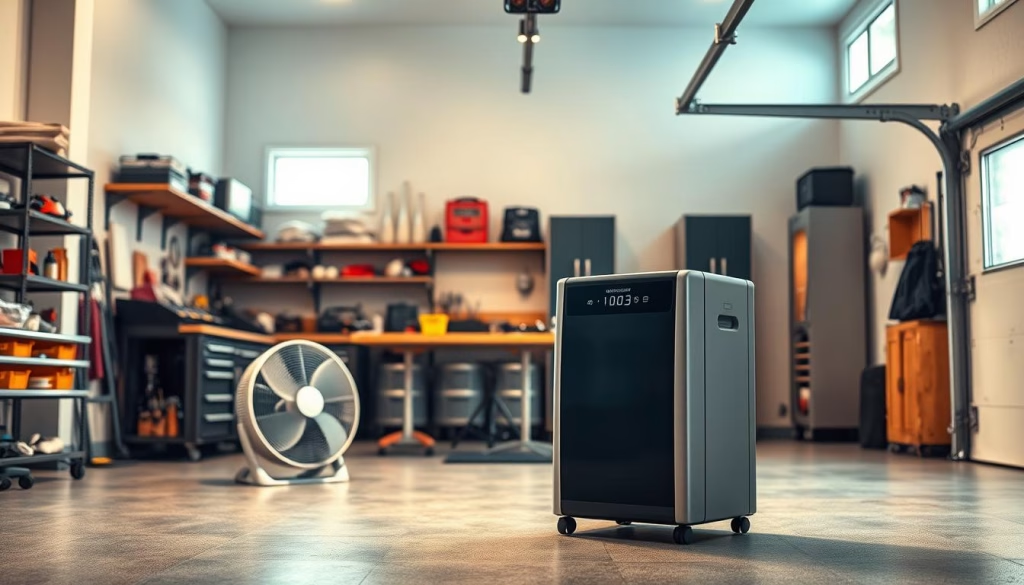
DIY Projects to Combat Hot Air in Your Garage
DIY projects can effectively combat hot air in your garage. They improve air circulation and protect against extreme temperatures. These efforts lead to better garage environments through DIY cooling solutions.
Building Ventilation Windows
Building ventilation windows lets fresh air into your garage, reducing heat. This project is easy with basic tools and materials. Position the windows for optimal airflow. This improves heating in winter and cooling in summer.
Installing Insulated Curtains
Insulated curtains block heat from garage windows effectively. They lower indoor temperatures and fit any space. Adding these curtains helps fight hot air in your garage.
Crafting Shade Structures
Shade structures like awnings or pergolas block sunlight. Use durable materials like treated wood or metal. These structures keep your garage cool and enhance your property’s look. They’re a practical and stylish way to cool your garage.
Professional Help for Long-Term Solutions
Many garage owners can tackle hot air issues on their own. Yet, some problems may need professional HVAC assistance for safety and effectiveness. It’s vital to know when to seek help. If you face complex installations or ongoing heat issues, experts can offer tailored solutions.
When looking for HVAC contractors, prioritize those with garage heating experience. Seek out certified professionals with a history of installing energy-efficient systems. They’ll not only offer expert advice but also recommend the best tools and resources for lasting results.
Exploring cost-effective garage solutions is also wise. Options like mini-split systems or advanced ventilation can offer long-term benefits. These choices help keep your garage comfortable while being budget-friendly. Getting professional help can make your garage cooler and more manageable for years.






